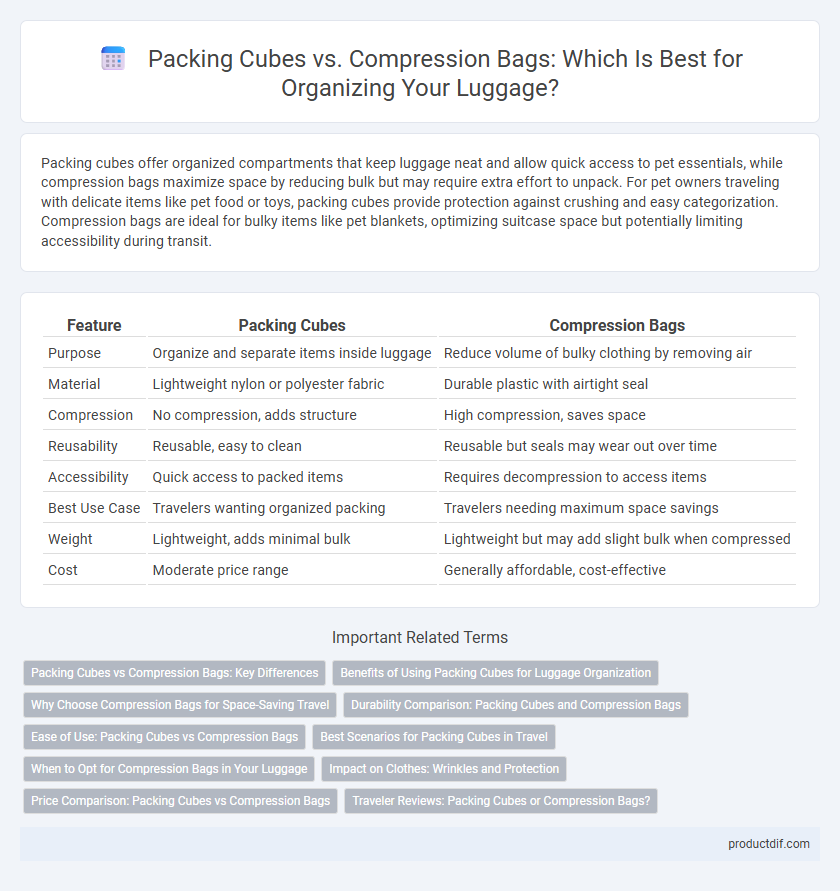Packing cubes offer organized compartments that keep luggage neat and allow quick access to pet essentials, while compression bags maximize space by reducing bulk but may require extra effort to unpack. For pet owners traveling with delicate items like pet food or toys, packing cubes provide protection against crushing and easy categorization. Compression bags are ideal for bulky items like pet blankets, optimizing suitcase space but potentially limiting accessibility during transit.
Table of Comparison
| Feature | Packing Cubes | Compression Bags |
|---|---|---|
| Purpose | Organize and separate items inside luggage | Reduce volume of bulky clothing by removing air |
| Material | Lightweight nylon or polyester fabric | Durable plastic with airtight seal |
| Compression | No compression, adds structure | High compression, saves space |
| Reusability | Reusable, easy to clean | Reusable but seals may wear out over time |
| Accessibility | Quick access to packed items | Requires decompression to access items |
| Best Use Case | Travelers wanting organized packing | Travelers needing maximum space savings |
| Weight | Lightweight, adds minimal bulk | Lightweight but may add slight bulk when compressed |
| Cost | Moderate price range | Generally affordable, cost-effective |
Packing Cubes vs Compression Bags: Key Differences
Packing cubes offer organized compartments that keep belongings separated and accessible, enhancing suitcase efficiency without altering item volume. Compression bags reduce the volume of soft items like clothing by removing air, maximizing space but requiring repacking to access contents. Choosing between them depends on prioritizing organization and convenience versus maximum space-saving in luggage packing.
Benefits of Using Packing Cubes for Luggage Organization
Packing cubes maximize luggage space by efficiently compartmentalizing clothes and accessories, allowing travelers to quickly locate items without unpacking the entire suitcase. Their rigid structure protects delicate garments from wrinkling and damage, enhancing overall travel convenience. These cubes also promote better packing habits by encouraging neat folding and separation of clothing categories for streamlined organization.
Why Choose Compression Bags for Space-Saving Travel
Compression bags maximize luggage space by significantly reducing the volume of bulky clothing and soft items through airtight sealing technology. Unlike packing cubes, which organize but do not compress, compression bags allow travelers to fit more into smaller suitcases, ideal for extended trips or limited baggage allowances. Their airtight design also protects belongings from moisture, dust, and odors, ensuring cleaner and more compact storage during travel.
Durability Comparison: Packing Cubes and Compression Bags
Packing cubes are generally made from durable nylon or polyester fabrics with reinforced stitching, offering long-lasting resistance to wear and tear during frequent travel. Compression bags, often constructed from thinner plastic materials, provide less durability and are more prone to punctures or seam failures under repeated use. For travelers seeking robust luggage organization tools, packing cubes typically outperform compression bags in terms of durability and longevity.
Ease of Use: Packing Cubes vs Compression Bags
Packing cubes offer straightforward organization with easy access to belongings, making them highly user-friendly for travelers who prioritize quick packing and unpacking. Compression bags reduce volume by vacuum-sealing clothes, but require additional steps such as rolling or pressing and often need a vacuum pump, which can complicate use. For ease of use, packing cubes typically provide a more convenient and hassle-free option compared to the more involved process of using compression bags.
Best Scenarios for Packing Cubes in Travel
Packing cubes are ideally suited for travelers seeking organized compartments within carry-on luggage, enabling efficient sorting of clothing and accessories by category or outfit. They facilitate easy access to items without disturbing the entire suitcase, making them perfect for multi-destination trips and frequent stops. Their breathable fabric design preserves garment freshness, making them advantageous for extended trips where ventilation and quick unpacking are priorities.
When to Opt for Compression Bags in Your Luggage
Compression bags maximize suitcase space by significantly reducing the volume of bulky items like jackets and sweaters, making them ideal for extended trips or when packing heavy clothing. They protect garments from moisture and odors due to their airtight seal, offering superior preservation compared to packing cubes. Travelers seeking to optimize limited luggage capacity while maintaining garment protection should opt for compression bags.
Impact on Clothes: Wrinkles and Protection
Packing cubes help maintain garment organization and minimize wrinkles by allowing clothes to lie flat and separated within compartments; they offer moderate protection against crushing. Compression bags significantly reduce volume by squeezing out air, but the tight packaging can increase wrinkle formation and stress fabric fibers, potentially causing damage. For delicate or structured clothing, packing cubes provide better wrinkle prevention and gentle protection, while compression bags are suitable for less wrinkle-prone items requiring maximum space-saving.
Price Comparison: Packing Cubes vs Compression Bags
Packing cubes generally offer a more affordable solution for organized travel, with sets typically priced between $15 and $40 depending on size and brand. Compression bags tend to be slightly more expensive, ranging from $20 to $50, due to their space-saving technology and durable materials. Travelers prioritizing budget-friendly packing organization often find packing cubes provide better value, while compression bags offer greater space efficiency at a higher price point.
Traveler Reviews: Packing Cubes or Compression Bags?
Travelers frequently praise packing cubes for their organizational benefits, allowing easy access and separation of items within luggage. Compression bags are lauded for maximizing space, particularly for bulky clothing, but some users note potential wrinkles and time-consuming repacking. Reviews consistently highlight that packing cubes suit frequent travelers valuing quick unpacking, while compression bags appeal to those prioritizing luggage space efficiency.
Packing cubes vs Compression bags Infographic

 productdif.com
productdif.com